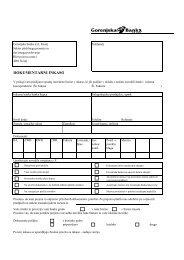Create successful ePaper yourself
Turn your PDF publications into a flip-book with our unique Google optimized e-Paper software.
2.5. Sale and repurchase agreements<br />
Securities sold subject to repurchase agreements (‘repos’) are reclassified in the financial statements<br />
as pledged assets when the transferee has the right by contract or custom to sell or repledge the<br />
collateral; the counterparty liability is included in amounts due to other banks, deposits from banks,<br />
other deposits or deposits due to customers, as appropriate.<br />
Securities purchased under agreements to resell (‘reverse repos’) are recorded as loans and<br />
advances to other banks or customers, as appropriate. The difference between sale and repurchase<br />
price is treated as interest and accrued over the life of the agreements using the effective interest<br />
method.<br />
2.6. Offsetting financial instruments<br />
Financial assets and liabilities are offset and the net amount reported in the statement of financial<br />
position when there is a legally enforceable right to offset the recognised amounts and there is an<br />
intention to settle on a net basis, or realise the asset and settle the liability simultaneously.<br />
2.7. Derivative financial instruments<br />
Derivatives, including futures and forward contracts, swaps and options are initially recognized in<br />
the statement of financial position at fair value. Fair values are obtained from quoted market prices,<br />
discounted cash flow models or pricing models. All derivatives are carried as assets when fair value<br />
is positive and as liabilities when fair value is negative.<br />
The bank does not apply hedge accounting.<br />
2.8. Interest income and expense<br />
Interest income and expense for all interest-bearing financial instruments, are recognised within<br />
'interest income' and 'interest expense' in the income statement using the effective interest method.<br />
Interest income includes coupons earned on fixed income investment and on securities designated<br />
at fair value through profit or loss and charged discount and premium on debt securities and other<br />
discounted instruments.<br />
The effective interest method is a method of calculating the amortised cost of a financial asset or a<br />
financial liability and of allocating the interest income or interest expense over the relevant period.<br />
The effective interest rate is the rate that exactly discounts estimated future cash payments or<br />
receipts through the expected life of the financial instrument. When calculating the effective interest<br />
rate, the Bank estimates cash flows considering all contractual terms of the financial instrument but<br />
does not consider future credit losses. The calculation includes all fees, transaction costs and all<br />
other premiums or discounts.<br />
Once a financial asset or a group of similar financial assets has been written down as a result of an<br />
impairment loss, interest income is recognised using the rate of interest used to discount the future<br />
cash flows for the purpose of measuring the impairment loss.<br />
63<br />
<strong>Gorenjska</strong> <strong>banka</strong>, d. d., Kranj<br />
<strong>Annual</strong> <strong>Report</strong> 2011<br />
Financial <strong>Report</strong>



